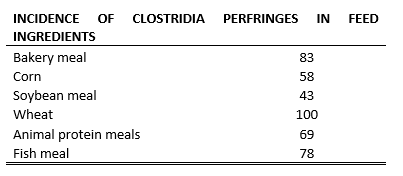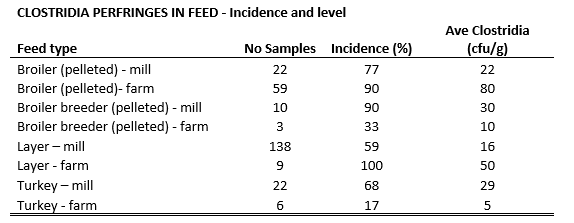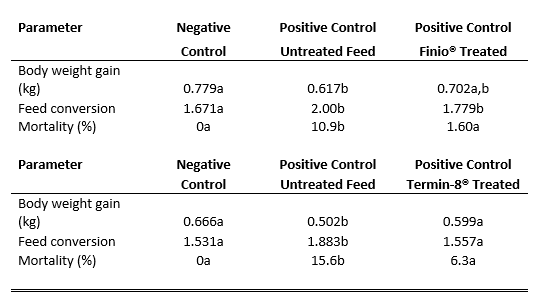- Posted by Anitox
Clostridia in Feed: A Challenge for Antibiotic-Free Poultry Production
The main reasons for eliminating the antibiotics growth promotors (AGPs) in the poultry production are due to legislation in some countries, farm sector agreements, antibiotic resistance, and marketing strategy.
In U.S.A., the USDA considers ionophores to be antibiotics as well as anticoccidials, so using them in growing programs for birds are not allowed, and these birds cannot be labeled as “raised without antibiotics”. Consequently, removing the antibiotic has come with challenges such as: 2-7% production decline, 3-5% increase in mortality rate (MacDonald & Wang, 2011). However, most of the production challenges are associated with subclinical or necrotic enteritis due to Clostridia.
Challenges in Antibiotic-Free Production
AGPs prevents colonization of the gut by eliminating pathogenic bacteria and make the gut more hostile to infection by modulating the mucosal immune system. For example, Clostridia thrives in the mucus produced as a result of inflammation, so controlling mucus production assist in controlling the infection. The proportion of broiler chickens raised without antibiotics in the United States has grown from less than 10% in 2014 to over 50% in 2019, and this has not come without challenges. Preventing infection and maintaining healthy gut in the birds are the main benefits of the using antibiotic growth promoters, not an easy task to replace. Antibiotics tend to target gram-negative bacteria as these are typically pathogenic. Without the antibiotics, the disease prevention approach has been changed. Also, the ionophore anticoccidial agents, which are classified as antibiotics in USA have been shown to reduce the level of anaerobic bacteria such as C. perfringens.
At the farm level, Clostridia presents a great challenge. Risk is present in all of the farm production. In the literature, the following values of Clostridia levels have been reported:
• Soil 9,300 cfu/g Li et al 2007
• Feces 105 cfu/g (in the bird) Kukier et al 2010
• Litter 7 cfu/g (in the bird) Williams and Macklin 2013
• Feed 103 cfu/g Kukier et al 2010
This means that for a 2.5 kg live weight bird and FCR ratio of 1.8, a broiler can consume 4.5 million Clostridia via the feed.
Clostridia in Feed Ingredients and Feed
Based on a global feed microbiological survey (Leethochawalit 2019) found the following values for Clostridia incidence in feed ingredients,
Table 1.
As previously shown, all feed ingredients registered high incidence of Clostridia, meaning that its entrance into the mill and later into the feed will remain to be a continuous challenge.
In another summary, the incidence of C. perfringens in different types of feeds is presented in Table 2 (Leethochawalit 2019).

Cl. perfringens in finished feed can vary considerably over time and between operations regardless of the presence in the ingredients. Pelleting is the most common method for controlling bacteria’s such as Clostridia in the mill. When done with the correct duration (several minutes), it is very effective at reducing bacteria level, however, this may require long retention time and high temperatures, and not all mills have this capacity, which may result in a backlog in their feed production. Clostridia is heat resistant, its spores can survive pelleting at 90o C (Maciorowski et al, 2007) and the pelleting process heat can stimulate the spore germination. In addition, it does not offer any residual protection hence, feed can be re-contaminated by bacteria as soon as it exits the pellet die and goes into the cooler. This may be a be challenge depending on how contaminated your system, feed bins, and farm silos are. Remember that feed can be remain in the farm silos from 1 – 7 days, giving the bacteria enough time to grow.
Impact of Clostridia
The impact of Clostridia in broilers is often recognized by the clinical symptom of necrotic enteritis. However, Clostridia can cause non-clinical symptoms which can affect productivity. Cl. perfringens accounts for 35 -40% of subclinical infections in broilers (McDevitt et al 2006). It is estimated that the cost of necrotic enteritis worldwide was 2 billion dollars per year, which includes not only direct loss due to broilers deaths, but also veterinary and cleaning costs (Vanderluis,2000;Timbermontetal.,2011).
A study was performed by S. Jayaraman, et al., to determine the impact of Clostridia on intestinal health and subsequent performance. Cobbs 500 broilers at 14 days of age, birds were challenged with coccidia to predispose the birds to a Clostridial challenge. Birds were dosed with Clostridia from 19-21 days of age. One-week post-challenge (6 birds/treatment), one bird per replicate was necropsied and the integrity (i.e villi length, lesions, etc.) of the intestinal tract determined. The trial was terminated at day 35. The results reflected that Clostridia reduced: the absorptive area of duodenum by 24.2% , body weight gain by 2.21% and feed conversion by 3.9%.
Impact of Clean Feed on Necrotic Enteritis
It has been recognized that feed can be a fomite of pathogens. How microbiologically clean does the feed comes out of the mill and how it stays until the bird consumes it, needs to be considered. What occurs during its manufacturing, feed mill storage, transportation, on-farm silos storage and farm feed lines, are important if the Clostridia challenge wants to be under control. Using proper interventions strategies such as Feed Sanitizers (aldehyde-based products), which provides residual protection to the feed and are more effective at eliminating sporulating bacteria in comparison to organic acids (Tortora et al 2005), is highly recommended.
Richardson, 2018 reported the effect of an aldehyde-based product on Clostridia levels in feed (Table 3).

The inclusion of the aldehyde-base product (Termin-8®) effectively reduced the incidence of Clostridia levels in the feed.
Another study, Richardson et al 2017, done with Clostridium perfringens showed the impact of clean feed on necrotic enteritis (Table 4).

The use of aldehyde-base products (Termin-8® / Finio®) in feeds for birds being challenge with Clostridium registered better feed conversion and lower mortality than birds challenge with Clostridium and fed non-treated feed. Feeding “cleaner feed” improved bird performance when Clostridia challenge was present.
Minimizing the incidence and level of Clostridia contamination in the feed, is an essential component of an integrated program aiming to reduce the risk of necrotic enteritis, especially in an antibiotic free poultry production operation.
-
- For more information on how feed sanitizers benefit the microbial quality of feed visit our website.


.png?width=300&height=175&name=Untitled%20design%20(83).png)